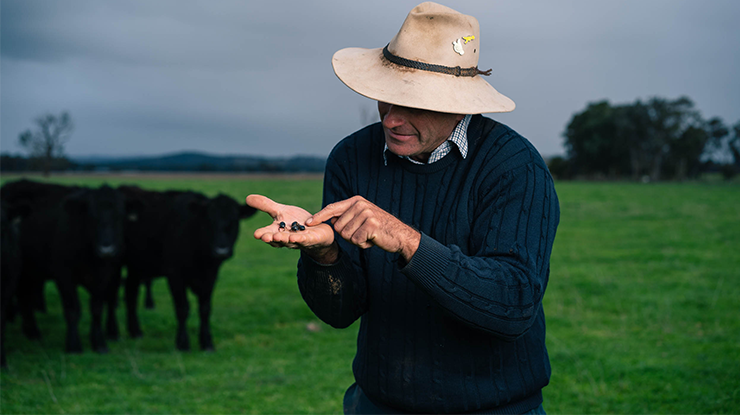
Dung beetles – the gift that keeps on giving
Dung beetles don’t just play a vital role in soil health and carbon storage – they can also help control flies.
An MLA-supported project, Dung Beetle Ecosystem Engineers, is expanding the range of dung beetles in Australia and digging deep to better understand how they work for livestock producers.
In this Q&A, insect ecologist Geoff Gurr, a Professor of Applied Ecology at Charles Sturt University, sheds some light on how these beetles can assist in bush fly management.
Q: Why do the bush flies seem to be worse than usual in southern Australia this year?
Bush flies don’t like conditions to be super hot and dry and they simply can’t survive cold winters, so the flies that are bothering us in southern Australia at the moment are often blow-ins from northern parts of the country. It’s the southern regions with cooler winters (that suppress fly numbers) that have the spring outbreak phenomenon caused by flies flying in from the north.
After arriving here, they can rapidly reproduce across multiple generations, especially if there are good supplies of dung for them.
Q: Why do flies and dung beetles go hand-in-hand?
Dung, in particular from ruminants, is an ideal breeding ground for flies – they think it’s Christmas when they’re surrounded by piles of dung. Fortunately, dung beetles compete with flies and can be so efficient that a dung pat is buried in as little as a day or two. This means the maggots don’t have time to develop – their lifecycle is halted in its tracks.
Another benefit is that the beetles bury the dung, converting this waste product into valuable plant fertiliser. If it wasn’t for these composting organisms, in a couple of years we’d be knee-deep in dung and surrounded by black clouds of flies.
Q: Has prolonged drought made it harder for dung beetles to keep flies in check?
Potentially. Dung beetles reproduce deep in the soil profile – depending on the species, they can be more than 50cm down. This keeps them safe from predators like birds but if the ground stays rock hard for a long period, they have a really hard time digging their way out and completing their development.
Another factor is that during drought, there is less dung around so this can also reduce dung beetle numbers. This can cause increased fly activity once dung does become available again because flies can respond immediately and complete their lifecycle in just weeks. Most dung beetles, in contrast, take at least a year to complete a generation.
Q: Are more dung beetles the solution?
When it comes to dung beetles, one size doesn’t fit all. There’s no single super-duper dung beetle that will control dung in all soil types, in all locations, in all parts of the year. They tend to specialise.
Back in the 1980s, CSIRO bought in dozens of species but unfortunately of the ones which successfully established, there aren’t many species that remain active during the spring months. This is another reason why we could be seeing large numbers of flies in parts of Australia this spring/summer, as the winter active dung beetles have finished and the summer active species haven’t properly matured yet.
To help fill seasonal and geographical gaps in current dung beetle activity in southern Australia, the ‘Dung Beetle Ecosystem Engineers’ project is breeding up and releasing three new dung beetle species introduced from North Africa and southern Europe. We hope they’ll complement the species that are already established in Australia to give greater continuity and coverage of dung beetle activity throughout the year.
Q: Flies aside, what are some of the other benefits of dung beetles?
One of the other important ecosystem services performed by dung beetles is controlling livestock parasites like gut worms. The dung of affected animals is packed full of worm eggs and the larvae that hatch from these lay waiting on neighbouring pasture plants, soon to be consumed by livestock which are then infected. Active, rapidly-colonising dung beetles can make fast work of worm-ridden pats. As the dung beetles consume dung, they kill the worm eggs, giving producers a natural control strategy.
Q: What’s the latest on the Dung Beetle Ecosystem Engineers project?
In recent weeks, project staff have been out distributing new beetles generated from our dung beetle rearing facilities. Throughout the project, tens of thousands of adults will eventually be distributed into new paddocks across southern Australia, in association with Landcare, farming systems or livestock groups aligned with the project.
One of the cool things about this project is that once we release the dung beetles, we can go back to release sites and – where there has been strong establishment – we can harvest a fraction of these beetles and release them on to more sites.



